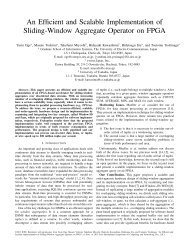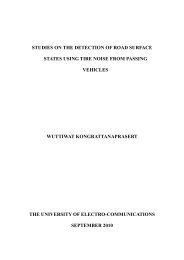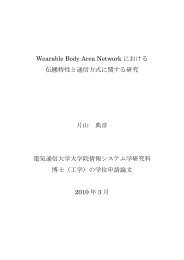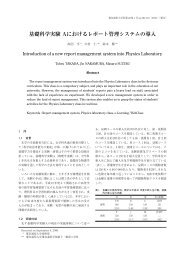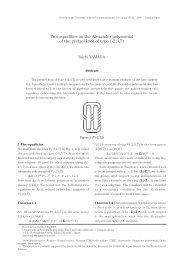a study on the spectrum efficient multi-hop wireless network
a study on the spectrum efficient multi-hop wireless network
a study on the spectrum efficient multi-hop wireless network
You also want an ePaper? Increase the reach of your titles
YUMPU automatically turns print PDFs into web optimized ePapers that Google loves.
adio is used for transmitting and receiving. And since <strong>the</strong> 802.11 MAC is naturally<br />
unpredictable because of <strong>the</strong> collisi<strong>on</strong> avoidance, radio cannot be used for two<br />
operati<strong>on</strong>s at <strong>the</strong> same time. This may stall <strong>the</strong> flow of <strong>the</strong> packets over <strong>multi</strong>-<strong>hop</strong><br />
<strong>wireless</strong> <strong>network</strong>s [12].<br />
As <strong>the</strong> data flow from <strong>the</strong> source to <strong>the</strong> destinati<strong>on</strong>, <strong>the</strong> intermediate nodes will<br />
update <strong>the</strong>ir timers associated with maintaining <strong>the</strong> route. For <strong>the</strong> case of AODV, <strong>the</strong><br />
routing table holds <strong>the</strong> current informati<strong>on</strong>:<br />
- Destinati<strong>on</strong>.<br />
- Next <strong>hop</strong>.<br />
- Number of <strong>hop</strong>s.<br />
- Destinati<strong>on</strong> sequence number.<br />
- Active neighbors for this route.<br />
- Expirati<strong>on</strong> time for this route table entry.<br />
Expirati<strong>on</strong> time is reset each time <strong>the</strong> route has been utilized using Eq. (2).<br />
2.5 Active Route Timeout and Mobility<br />
The Ad hoc On-Demand Distance Vector Routing Protocol (AODV) is a routing<br />
protocol which is intended to be used in high mobile Ad-hoc <strong>network</strong>s. AODV is a<br />
reactive protocol where <strong>the</strong> route discovery process is initiated <strong>on</strong>ly when it is needed.<br />
MANET routing protocol plays an important role in <strong>the</strong> performance of <strong>the</strong> <strong>network</strong>. A<br />
wide range of parameters c<strong>on</strong>trols <strong>the</strong> behavior of <strong>the</strong> routing protocol. One particular<br />
parameter in AODV is <strong>the</strong> Route states hold time.<br />
When <strong>the</strong> route is not used for some time, <strong>the</strong> nodes remove <strong>the</strong> route from its routing<br />
table. The time until <strong>the</strong> nodes remove <strong>the</strong> route states is called <strong>the</strong> Active Route<br />
Timeout (ART). In o<strong>the</strong>r words, ART is <strong>the</strong> time after <strong>the</strong> route is c<strong>on</strong>sidered invalid.<br />
In an Ad-hoc mobile <strong>network</strong>, <strong>the</strong> stati<strong>on</strong> movement speed is very crucial. The speed<br />
has an effect <strong>on</strong> <strong>the</strong> throughput. Fig 2.4 is an example <strong>on</strong> how <strong>the</strong> mobility has an effect<br />
<strong>on</strong> <strong>the</strong> c<strong>on</strong>nectivity between <strong>the</strong> stati<strong>on</strong>s. In a normal case, node C will have to<br />
communicate with node A through node B. however, since node C is moving closer to A,<br />
it can communicate directly to node A. This example illustrates <strong>on</strong>ly <strong>on</strong>e case in which<br />
<strong>the</strong> stati<strong>on</strong> movement could be an advantage in MANET [19].<br />
14



